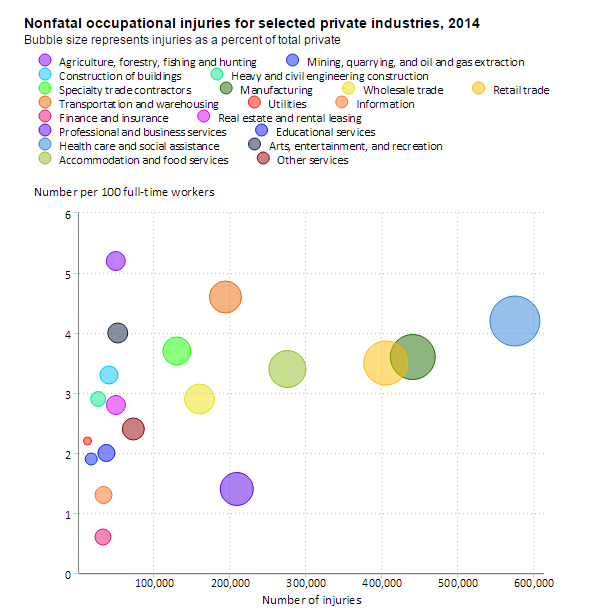It’s that time of year again – on February 1, we will all be posting our OSHA 300A injury/illness summary. Emilcott reviewed this in a recent blog, OSHA Forms, and in following this theme, we thought it might be interesting to look at some of the data provided by the Bureau of Labor Statistics (BLS) about 2014 injury and illness incident rates.
Read MoreEnvironmental Health and Safety Blog | EHSWire
How Do Your Injury Statistics Compare With Other Companies?
Posted by Emilcott Associates
Topics: workplace injuries and illness, OSHA Injury, establishment-specific injury and illness data, annual Occupational Injuries and Illnesses Report, severe work-related injury and fatality reporting, final rule revision to the Injury and Illness Reco, injury, Bureau of Labor Statistics, OSHA Injury and Illness Recordkeeping and Reportin, osha 300, incident rates, industies
What Workers and Managers Should Know About Emergency Eyewashes
Posted by Shivi Kakar
The CDC reports that each day more than 2,000 U.S. workers receive some form of medical treatment due to eye injuries sustained at work. More than 800,000 work-related eye injuries occur each year. Most of these injuries result from objects entering the eyes, but many are caused by chemicals. Wearing appropriate eye protection and working safely go a long way toward preventing these types of injuries. However, because nothing is 100%, OSHA requires certain areas in the workplace where chemicals are used or stored to be equipped with emergency eyewash stations and, in some cases, emergency drench showers. The OSHA Medical Services and First Aid Standard covering this area [29 CFR 1910.151 (c)] states:
"Where the eyes or body of any person may be exposed to injurious corrosive materials, suitable facilities for quick drenching or flushing of the eyes and body shall be provided within the work area for immediate emergency use."
If you are working with or storing corrosive materials your facility must have such installations. Like a fire extinguisher on the wall, you hope you never need an emergency eyewash station, but youd better be able to get to it and it had better work when there is a need. Its important to know that chemical burns and damage start immediately upon contact. The sooner the rinsing starts, the less damage will occur.
The main function of rinse stations (portable or fixed) is first aid, and it is only step one. Immediate and appropriate medical treatment is the next step -- whether it is calling 911 or transporting the injured person to the nearest medical facility. Someone from your facility, preferably a manager, should stay with the injured worker and have a copy of the MSDS and any incident information that could be helpful to the medical personnel.
Emilcott staff work at a variety of industrial, commercial, construction and other hazardous sites. For many facilities and jobs, an eyewash station is an essential part of the health and safety plan. As an EMT and CHMP, these are some of the questions I ask when assessing the suitability of flushing stations:
- Do area workers know where emergency eyewash and shower stations are located, AND how they operate?
- Are the stations accessible? Not blocked or obstructed?
- The route to all flushing stations must be clear and the locations boldly marked; could everyone get to a station when neededFAST and possibly without looking?
- Has the equipment been inspected and tested monthly? Has this been documented?
- Is the system plumbed with fixed piping? Or is it a stored liquid type? The former must be flushed and the latter must have its water supply treated so that it remains stable. Both must be capable of delivering at least 15 minutes worth of flow.
- Is the water at a comfortable temperature?
While there are many products on the market, we recommend the Speakman Gravityflo® Portable Eyewash & Drench Station and use one as a training tool for students in our Hazardous Waste Operations / Emergency Response training courses. An important component in an effective HazWOPER (and all H&S) training program is the hands-on experience so that students know what to expect in the field. Instead of a slide on an eyewash station, we roll our portable unit to the front of the class or outside for the field exercise, show them how to use it and why it is critical for the eyewash station to be close, ready, and working in the event of an emergency. If your job function is near where chemicals are used or stored, you should know as much about your nearest eyewash station as our students do!
If you work at a site with corrosive materials present, how available are emergency flushing stations? Can these stations be accessed within 10 seconds? Has anyone ever showed you how to use it blindfolded?
Topics: OSHA, First-Aid, General Industry H&S, OSHA Compliance, General EHS, Construction H&S, Emergency Response, H&S Training, Hazardous Waste Management, protection, eyewash, emergency, drench, corrosive, flush, Lab Safety & Electrical, injury, eye




